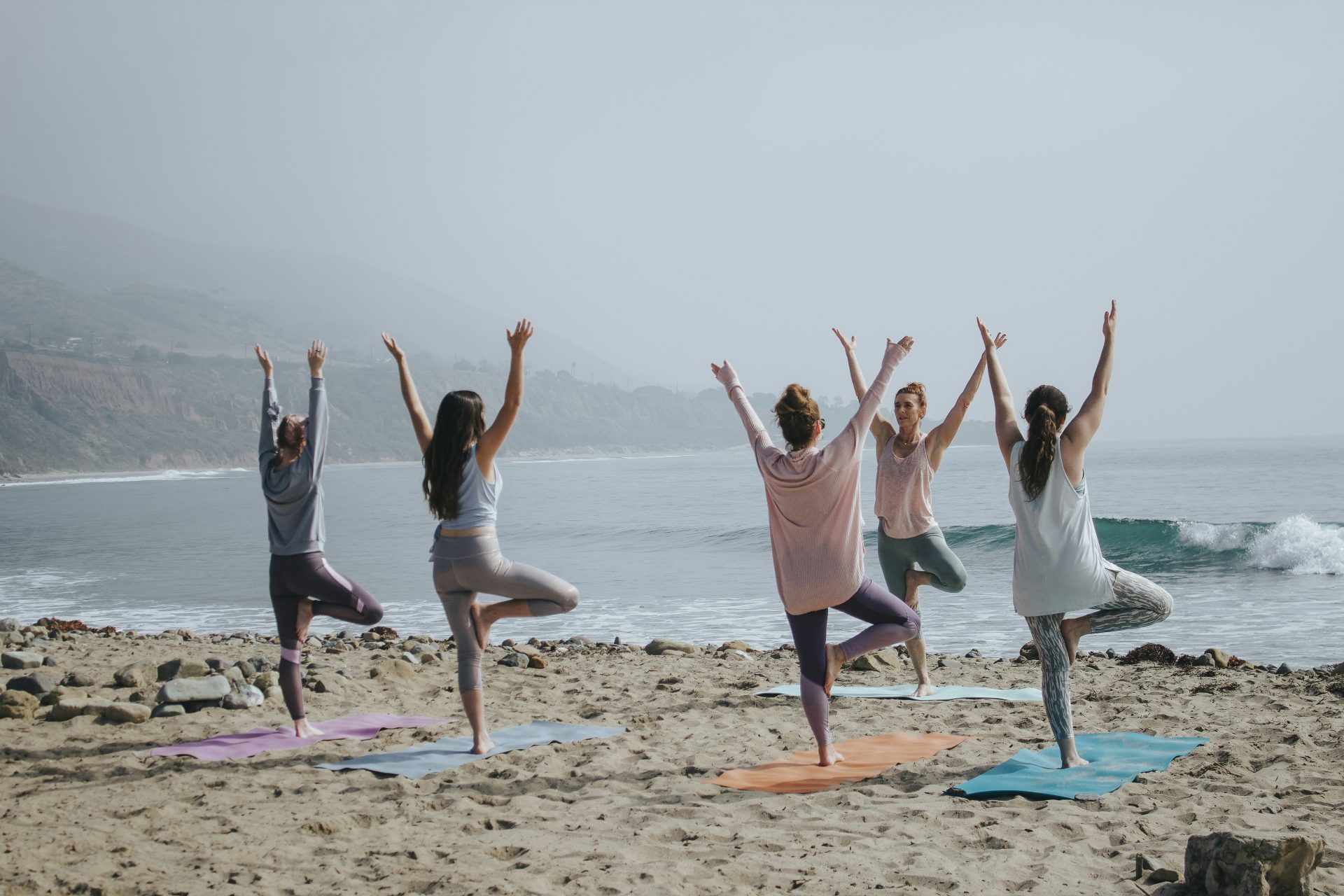Finding Inner Peace with Yoga Practices

Before diving in, please note: This post is for informational purposes only. If you’d like to know more about how we approach topics, feel free to check out our friendly Disclaimer Page.
Hey there, amazing readers! 🖐️ Just a quick note: yes, we know there are a lot of ads here. Trust us, we get it—it’s not the prettiest look, but they help us keep this blog alive and kicking. Those pesky little ads cover the costs of all the behind-the-scenes magic, from hosting and tech stuff to creating content we hope you’ll love.
We’re committed to delivering quality posts, and your support (even just sticking around despite the ads) means everything to us. So, bear with us, and thanks for helping us keep the good vibes rolling. Now, on to the fun stuff! 😉
TRANSLATE BUTTON AT THE END OF THE ARTICLE
A Quick Overview
Finding inner peace is a journey many of us embark on, especially in today’s fast-paced world.
Yoga has emerged as a beacon of hope, providing tools and techniques to help us attain this calmness amidst chaos.
This article will guide you through the various aspects of yoga practices that lead to inner tranquility, from understanding its connection to mental well-being to incorporating it into your daily life.
So, grab your yoga mat, find a quiet spot, and let’s explore how we can cultivate peace together!
Understanding Inner Peace: The Yoga Connection
Inner peace is often described as a state of mental and emotional calm.
It’s that sweet spot where stress and anxiety take a backseat, allowing you to breathe freely.
Yoga promotes this peace by harmonizing the body and mind.
When we practice yoga, we learn to focus on the present moment, which can be a game-changer in our hectic lives.
Yoga is much more than just physical postures.
It’s a holistic approach that encompasses breath control, meditation, and ethical principles.
These elements work synergistically to help us confront our thoughts and emotions instead of running from them.
This practice encourages us to reflect inward, fostering a deep sense of tranquility.
Imagine sitting quietly on your mat, feeling the rhythm of your breath.
With each inhale, you’re inviting in peace, and with each exhale, you’re letting go of tension.
Over time, this simple act can reshape your mental landscape, paving the way for serenity to flourish.
Integrating yoga into our lives can offer an anchor during turbulent times.
It helps us cultivate resilience, allowing us to navigate challenges with grace.
Through consistent practice, we transform our relationship with stress, learning to respond instead of react.
In essence, yoga serves as a guiding light on our journey to inner peace.
It teaches us to cultivate mindfulness, embrace stillness, and find joy in the present.
So, let’s dive deeper into how yoga can enhance our mental well-being.
The Benefits of Yoga for Mental Well-Being
Yoga has a plethora of mental health benefits that can significantly enhance our quality of life.
Research shows that regular practice can reduce symptoms of anxiety and depression.
The combination of movement, breathwork, and meditation works wonders for our state of mind.
Reduces Stress: As we engage in yoga, our body releases tension and stress.
The focus on breathing helps lower cortisol levels, the hormone associated with stress.
Improves Mood: Have you ever noticed how a yoga session can uplift your spirits?
This is due to the increase in serotonin production, the "feel-good" hormone.
Enhances Focus: Through concentration on breath and movement, yoga sharpens our focus.
This can lead to increased productivity in our daily tasks.
Promotes Emotional Regulation: By understanding our emotions better, we learn to manage them effectively.
Yoga provides the tools to respond mindfully rather than impulsively.
Fosters Self-Compassion: Practicing yoga encourages self-acceptance.
We learn to be kinder to ourselves, leading to improved self-esteem and confidence.
Creates Mindfulness: Yoga teaches us to be present in the moment.
This mindfulness practice can translate into greater awareness in our daily lives.
Encourages Better Sleep: Many people find that yoga helps with sleep quality.
The relaxation techniques learned during practice can ease insomnia and promote deeper rest.
Strengthens Resilience: Regular practice builds our mental fortitude.
We become better equipped to handle life’s ups and downs.
Connects Body and Mind: Yoga harmonizes our physical and mental states, allowing for a more integrated sense of self.
Cultivates Community: Participating in group classes fosters a sense of belonging, which can be incredibly beneficial for mental health.
These benefits are just the tip of the iceberg.
The more I practice, the more I notice the positive ripple effects in my life.
So, how do we begin this transformative journey?
Let’s explore the importance of setting intentions.
Setting Intentions: Your Journey Begins Here
Intentions are like guiding stars on our journey to inner peace.
When we start our yoga practice, it’s essential to set an intention.
Think of it as a personal mantra or goal, giving your practice purpose and direction.
Reflect on Your Needs: Before stepping onto the mat, take a moment to reflect.
What do you hope to achieve through your practice?
Is it relaxation, strength, or perhaps self-discovery?
Keep It Simple: Your intention doesn’t need to be grand.
Even something as simple as "I want to be present" can be powerful.
Write It Down: Jotting down your intention can solidify your commitment.
It’s a reminder of what you’re working towards.
Revisit Your Intention: As you progress, check in with yourself.
Does your initial intention still resonate with you?
Don’t hesitate to adjust it.
Share It: Sometimes, sharing your intention with a friend or fellow yogi can enhance accountability.
Plus, it opens the door for supportive discussions.
Be Patient: Remember, cultivating inner peace is a journey.
Don’t rush the process; allow your intention to unfold naturally.
Integrate It: Bring your intention into your practice.
Each time you flow through a pose, remind yourself of your goal.
Stay Open-Minded: Be willing to embrace whatever arises during your practice.
Sometimes, what we need becomes clear only after we’ve begun.
Celebrate Small Wins: Acknowledge the progress you make, no matter how small.
Each step counts on the path to peace.
End with Gratitude: Conclude your practice by expressing gratitude for your journey and the insights gained.
Setting intentions creates a sense of purpose that enriches our yoga experience.
Now that we’ve planted the seeds of intention, let’s explore a key aspect of yoga—breath.
Breathing Techniques: The Key to Calmness
Breath is the bridge between the body and mind.
In yoga, we often hear the phrase, "breathe into your practice." This isn’t just poetic language; it’s a vital component for cultivating calmness and focus.
Diaphragmatic Breathing: Also known as belly breathing, this technique encourages you to breathe deeply into your diaphragm.
This activates the relaxation response in the body.
Box Breathing: Inhale for four counts, hold for four, exhale for four, and pause for four.
This rhythmic breathing helps to regulate the nervous system.
Alternate Nostril Breathing (Nadi Shodhana): This technique balances the mind and body.
Close one nostril, inhale through the other, then switch.
It’s quite soothing.
Ujjayi Breath: Often referred to as "victorious breath," this technique involves slightly constricting the throat while breathing.
It creates a soft sound, enhancing focus.
Sighing Breath: Inhale deeply, then exhale with a sigh.
This can release pent-up tension and provide instant relief.
Four-Part Breath: Inhale, hold, exhale, and hold again.
Each phase lasts the same amount of time.
This structured approach calms the mind.
Visualizing Breath: As you breathe, imagine inhaling light and exhaling negativity or tension.
Visualization can amplify the therapeutic effects of breath.
Mindful Breathing: Simply focus on your breath without altering it.
Notice the sensations and rhythm.
Breath Awareness in Poses: Pay attention to your breath as you transition between poses.
This connection enhances your practice.
Integrating Breath into Daily Life: Don’t reserve conscious breathing for the mat.
Whenever you feel stressed, pause, and take a few deep breaths to regain your center.
By mastering these breathing techniques, we can cultivate a sense of calm that permeates every aspect of our lives.
With a strong foundation in breathwork, let’s explore essential yoga poses for inner peace.
Essential Yoga Poses for Inner Peace
Certain yoga poses are particularly effective for promoting inner calm.
Here are some of my favorites that you can easily incorporate into your routine:
Child’s Pose (Balasana): This gentle pose fosters relaxation and helps ease tension in the back.
It’s a perfect way to start or end your practice.
Cat-Cow Stretch (Marjaryasana-Bitilasana): This flowing movement helps release spinal tension and encourages mindful breathing.
Forward Fold (Uttanasana): This pose calms the mind and relieves stress.
As you fold, let go of any negative energy.
Bridge Pose (Setu Bandhasana): This pose opens the heart and chest, promoting emotional release.
It can help you feel more grounded.
Legs-Up-The-Wall Pose (Viparita Karani): Elevating your legs supports blood circulation and relaxation.
It’s a great way to unwind after a long day.
Seated Forward Bend (Paschimottanasana): This calming pose encourages introspection and relaxation.
Take a moment to breathe deeply here.
Tree Pose (Vrksasana): This balancing pose cultivates focus and stability.
It encourages a sense of inner strength.
Corpse Pose (Savasana): Often the finale of a yoga session, Savasana is essential for integrating your practice.
It’s a time to embrace stillness.
Reclining Bound Angle Pose (Supta Baddha Konasana): This restorative pose opens the hips and promotes deep relaxation.
It’s especially lovely with props.
Seated Meditation (Dhyana): While not a pose per se, sitting in meditation allows for a deep exploration of inner peace.
Focus on your breath and let thoughts come and go.
Integrating these poses into your practice can help you cultivate a deeper connection to your inner self.
Now that we’re moving through our practice, let’s explore how to flow with mindfulness.
Mindfulness in Motion: Flowing with Your Breath
Mindfulness is the art of being present, and it plays a crucial role in yoga.
When we flow through poses with intention and awareness, we deepen our connection to ourselves.
Focus on Transitions: Pay attention to the space between poses.
Each transition is an opportunity to breathe and reflect.
Synchronize Movement with Breath: Inhale as you rise, exhale as you fold.
This rhythm enhances your practice and encourages mindfulness.
Practice Non-Judgment: Allow yourself to experience each pose without self-criticism.
This acceptance cultivates compassion and peace.
Listen to Your Body: Be attentive to what your body needs.
If something doesn’t feel right, modify or rest.
Your practice is yours alone.
Limit Distractions: Turn off your phone and create a serene environment.
The less distracted you are, the easier it is to find your center.
Engage Your Senses: Notice the sounds, smells, and sensations around you.
Engaging your senses anchors you in the present moment.
Set a Gentle Pace: There’s no rush in yoga.
Move slowly and deliberately, allowing time for reflection.
Practice Gratitude: During your practice, take a moment to express gratitude for your body and breath.
This mindset fosters positivity.
Incorporate Affirmations: Use affirmations like “I am at peace” during your flow.
This reinforces your intention for inner tranquility.
Embrace Silence: Sometimes silence speaks louder than words.
Take moments of stillness to connect with your inner self.
As we flow mindfully, we create a sanctuary within ourselves.
Next, let’s explore how to set up a serene space for our practice.
Creating a Serene Space for Your Practice
Your environment can significantly impact your yoga practice.
Creating a serene space is essential for fostering inner peace.
Choose a Quiet Spot: Find a space that feels calming and inviting.
It could be a corner of your living room, a garden, or even a cozy nook.
Declutter: A tidy space promotes a clear mind.
Remove items that distract you from your practice.
Add Natural Elements: Incorporate plants, candles, or crystals to enhance the ambiance.
Nature has a calming effect on our well-being.
Create Soft Lighting: Dim lighting or candles can create a soothing atmosphere.
Avoid harsh or bright lights that can feel jarring.
Use Comfortable Props: Pillows, bolsters, or blankets can enhance your practice.
Comfort allows you to focus more on your breath and body.
Add Personal Touches: Display items that inspire you, such as art, meaningful quotes, or photographs.
Surrounding yourself with positivity enhances your experience.
Consider Sound: Listen to calming music or nature sounds.
Alternatively, enjoy the quiet; silence can be incredibly peaceful.
Set Boundaries: Inform those around you that you’re taking time for yourself.
This helps minimize interruptions during your practice.
Practice Consistently: Create a routine around your practice.
Consistency transforms your space into a sanctuary.
Leave Space for Flexibility: While it’s great to have a designated area, don’t stress if you need to practice elsewhere.
Remember, your inner peace resides within you.
By creating a serene space, we lay the foundation for a nurturing practice.
Now, let’s delve into the art of meditation, another powerful tool for achieving tranquility.
Meditation: A Pathway to Deeper Tranquility
Meditation is like a silent retreat for the mind.
It allows us to connect with our inner selves and cultivate deep peace.
Here’s how to incorporate meditation into your yoga practice:
Start Small: If you’re new to meditation, begin with just a few minutes.
Gradually extend your time as you become more comfortable.
Find a Comfortable Position: Sit or lie down in a way that feels good for you.
Comfort helps you focus on your breath rather than distractions.
Focus on Your Breath: Bring your awareness to your breath.
Notice the sensation of air flowing in and out.
This anchors you in the present moment.
Use Guided Meditations: Many apps and online platforms offer guided meditations.
These can be helpful, especially for beginners.
Explore Visualization: Picture a peaceful scene—a beach, forest, or mountain.
Visualizing tranquility can deepen your sense of calm.
Practice Loving-Kindness: Send positive thoughts and wishes to yourself and others.
This practice cultivates compassion and love.
Embrace Imperfection: Your mind may wander.
It’s normal!
Gently bring your focus back to your breath without judgment.
Incorporate Meditation into Your Yoga Practice: Conclude your yoga session with a few minutes of meditation.
This helps integrate the benefits of your practice.
Carry Mindfulness Throughout the Day: Try to incorporate moments of mindfulness into everyday activities, like eating or walking.
Be Patient: Remember, meditation is a skill that takes time to develop.
Be gentle with yourself as you navigate this journey.
By weaving meditation into our lives, we can cultivate a profound sense of peace.
Now, let’s discuss how to incorporate yoga into our daily routines.
Incorporating Yoga into Your Daily Routine
Integrating yoga into your daily life doesn’t require hours of spare time.
Small, intentional practices can make a significant difference in cultivating inner peace.
Morning Flow: Start your day with a short morning routine.
Even 10 minutes of stretching can set a positive tone for the day.
Midday Breaks: Take a few moments to step away from your desk.
A few stretches or mindful breaths can recharge your energy.
Evening Wind-Down: Consider a gentle evening routine to release the day’s stress.
A few calming poses before bed can lead to a restful night.
Mindful Moments: Practice mindfulness in simple activities like brushing your teeth or drinking tea.
Bring your full awareness to the task at hand.
Utilize Online Resources: Explore online classes or videos that fit your schedule.
This flexibility allows you to practice whenever and wherever you want.
Join a Class: Consider attending local yoga classes.
Being part of a community enhances motivation and accountability.
Set Reminders: Use your phone to set reminders for short practice sessions.
A little nudge can help you stay committed.
Make it a Habit: Try to practice at the same time each day.
Consistency turns yoga into a natural part of your routine.
Be Kind to Yourself: Some days may be busier than others.
That’s okay!
A few minutes of breathwork can still offer benefits.
Reflect on Your Progress: Keep a journal to track how you feel after your practice.
This reflection can reinforce the positive effects of yoga.
Incorporating yoga into daily life creates a sense of continuity in our pursuit of inner peace.
Yet, challenges can arise.
Let’s explore how to stay committed.
Overcoming Challenges: Staying Committed to Peace
We all face hurdles on our journey to inner peace.
Whether it’s time constraints or self-doubt, addressing challenges is vital for maintaining a consistent practice.
Acknowledge Your Feelings: It’s okay to feel discouraged or unmotivated.
Acknowledge those feelings without judgment.
Start Small: If time is tight, commit to just a few minutes of practice.
Short sessions can still be incredibly beneficial.
Find Your Motivation: Reflect on why you started practicing yoga.
Reconnecting with your purpose can reignite your motivation.
Mix It Up: If you’re feeling bored, try new styles or classes.
Variety keeps your practice fresh and exciting.
Seek Support: Share your goals with friends or join classes.
Having a support system can boost your commitment.
Celebrate Progress: Acknowledge even the smallest victories.
Celebrating progress keeps your spirits high and encourages you to keep going.
Practice Self-Compassion: Be kind to yourself when you miss a session.
Life happens, and it’s all part of the journey.
Create Accountability: Partner with a friend for practice sessions.
Having someone rely on you can motivate you to show up.
Reflect on Benefits: Regularly remind yourself how yoga positively impacts your life.
This reflection reinforces the value of your practice.
Embrace Flexibility: Understand that your practice will evolve over time.
Be open to changes in your routine and adapt as needed.
Commitment to yoga is a personal journey, but it’s one that often pays off immensely.
As we navigate our path, let’s also explore the community aspect of yoga.
Community and Connection: Yoga Beyond the Mat
Yoga isn’t just an individual practice; it promotes connection and community.
Engaging with others can enhance our journey toward inner peace.
Join Classes: Attending group classes creates a sense of belonging.
You’ll meet like-minded individuals who share your passion.
Attend Workshops: Workshops offer opportunities for deeper exploration.
They also allow you to connect with others in a more intimate setting.
Participate in Retreats: Yoga retreats provide immersive experiences.
They allow you to bond with fellow practitioners while deepening your practice.
Engage Online: Join online yoga communities or social media groups.
These platforms allow you to connect with yogis worldwide.
Support Local Studios: Get involved with your local yoga studio.
Attend events, volunteer, or join discussions to foster connection.
Share Your Journey: Talk about your experiences with friends or family.
Sharing your journey can inspire others and create meaningful conversations.
Collaborate with Others: Practice with friends or family.
Sharing your practice can enhance joy and accountability.
Be Open to New Connections: Engage with fellow practitioners.
You never know whom you might meet on your journey!
Celebrate Community Events: Attend local yoga events or charity classes.
These gatherings foster a sense of togetherness.
Reflect on the Power of Connection: Recognize how community enhances your practice.
The support and encouragement of others can be incredibly uplifting.
Community adds a rich layer to our yoga experience, reminding us that we’re all in this together.
Finally, let’s celebrate our growth and embrace inner harmony.
Celebrating Your Growth: Embracing Inner Harmony
The journey to inner peace is ongoing.
As we practice yoga, it’s essential to celebrate our growth and acknowledge the milestones we achieve.
Reflect on Your Journey: Take time to look back on where you started.
Acknowledging progress can inspire further growth.
Set New Goals: As you achieve your initial intentions, set new goals.
This keeps your practice dynamic and exciting.
Practice Gratitude: Regularly express gratitude for your practice and the insights gained.
Gratitude fosters positivity and contentment.
Share Success Stories: Talk about your journey with friends or community members.
Sharing victories can inspire others to pursue their paths.
Create a Celebration Ritual: Mark significant milestones in your practice with a celebration.
It could be as simple as treating yourself to a special activity.
Stay Curious: Continue exploring different styles, poses, or meditation techniques.
The journey is ongoing, and there’s always more to learn.
Connect with Your Body: Recognize the changes in your body and mind as you progress.
Celebrate the strength and resilience you cultivate.
Embrace Change: Accept that growth involves change.
Allow your practice to evolve as you do.
Encourage Others: Share encouragement with others on their journeys.
Supporting fellow practitioners creates a nurturing community.
Remember the Journey: Ultimately, the journey itself is the destination.
Embrace each moment, savoring the beauty of growth.
By celebrating our growth, we cultivate inner harmony and inspire others to embark on their own journeys toward peace.
Conclusion
Finding inner peace through yoga practices is a transformative journey filled with growth, connection, and self-discovery.
By understanding the connection between yoga and mental well-being, setting intentions, and embracing mindfulness, we can navigate the chaos of life with grace and calm.
The tools and techniques we’ve explored, from breathing exercises to essential poses, serve as stepping stones toward cultivating a deeper sense of tranquility.
As we overcome challenges, embrace community, and celebrate our achievements, we find ourselves more attuned to our inner selves.
So, whether you’re just starting or have been practicing for years, remember that every step on this journey is valuable.
Let’s continue to share our experiences, support one another, and nurture the peace that resides within us all.
Grab your mat, breathe deeply, and let the journey unfold!

The Enlightenment Journey is a remarkable collection of writings authored by a distinguished group of experts in the fields of spirituality, new age, and esoteric knowledge.
This anthology features a diverse assembly of well-experienced authors who bring their profound insights and credible perspectives to the forefront.
Each contributor possesses a wealth of knowledge and wisdom, making them authorities in their respective domains.
Together, they offer readers a transformative journey into the realms of spiritual growth, self-discovery, and esoteric enlightenment.
The Enlightenment Journey is a testament to the collective expertise of these luminaries, providing readers with a rich tapestry of ideas and information to illuminate their spiritual path.
Our Diverse Expertise 🌟
While our primary focus is on spirituality and esotericism, we are equally passionate about exploring a wide range of other topics and niches 🌍📚. Our experienced team is dedicated to delivering high-quality, informative content across various subjects ✨.
To ensure we provide the most accurate and valuable insights, we collaborate with trusted experts in their respective domains 🧑🏫👩🏫. This allows us to offer well-rounded perspectives and knowledge to our readers.
Our blog originally focused on spirituality and metaphysics, but we’ve since expanded to cover a wide range of niches. Don’t worry—we continue to publish a lot of articles on spirituality! Frequently visit our blog to explore our diverse content and stay tuned for more insightful reads.






